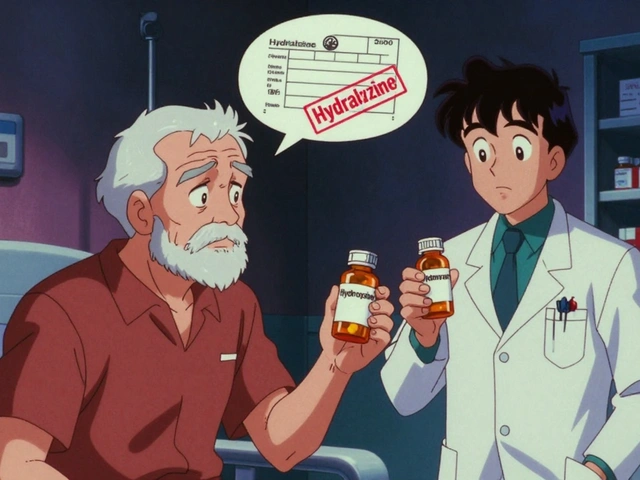For decades, diagnosing and tracking cancer meant sticking a needle into a tumor-sometimes deep in the lung, liver, or bone-to pull out a piece of tissue. It was painful, risky, and often impossible if the tumor was in a hard-to-reach spot. Even when doctors got a sample, it only showed a snapshot of one part of the cancer. But what if you could test for cancer using just a simple blood draw? That’s not science fiction anymore. It’s happening in hospitals right now, thanks to circulating tumor DNA and liquid biopsy.
What Is Liquid Biopsy and How Does It Work?
Liquid biopsy isn’t a surgery. It’s a blood test that looks for tiny pieces of DNA shed by cancer cells into your bloodstream. These fragments are called circulating tumor DNA, or ctDNA. When a tumor grows, dies, or breaks apart, it releases bits of its genetic material into the blood. ctDNA carries the same mutations as the original tumor-so by analyzing it, doctors can see what’s driving the cancer without ever touching the tumor itself. This isn’t just about finding cancer. It’s about watching it change over time. Traditional biopsies are one-time events. Liquid biopsies can be done every few weeks. That means doctors can track whether a treatment is working, spot new mutations that make the cancer resistant to drugs, or catch a recurrence months before a scan shows anything. The most common way to detect ctDNA is through next-generation sequencing (NGS) or digital droplet PCR (ddPCR). These methods are so sensitive they can find one cancer DNA molecule in a sea of 10,000 healthy ones. Some newer techniques even look at how long the DNA fragments are, where they come from in the genome, or whether they’ve been chemically marked by methylation-changes that happen early in cancer development and can improve detection by 20-30%.Why ctDNA Beats Traditional Biopsies for Monitoring
Tissue biopsies have three big problems: they’re invasive, they’re limited to one spot, and you can’t do them often. A lung biopsy can cause a collapsed lung. A liver biopsy can bleed. And if the tumor is in the pancreas or brain, the risk might be too high to repeat. Liquid biopsy fixes all that. It’s a simple arm prick. No anesthesia. No recovery. And because it captures DNA from all parts of the tumor-not just one biopsy site-it gives a fuller picture of the cancer’s genetic landscape. Studies show single-site biopsies miss up to 30% of key mutations because tumors aren’t uniform. ctDNA reflects the whole tumor, including hidden or spreading cells. It’s especially useful when tissue isn’t available. About 20-30% of patients don’t have enough tissue left from their original biopsy to test for targetable mutations. In those cases, liquid biopsy finds a targetable EGFR mutation in 92% of non-small cell lung cancer patients, according to research in Nature Signals Transduction and Targeted Therapy (2024). That means more people get the right drug, faster.
When Liquid Biopsy Works Best-and When It Doesn’t
Not all cancers shed ctDNA equally. That’s the biggest limitation. Cancers like colorectal, lung, and breast cancer release a lot of DNA into the blood. In stage IV disease, ctDNA detection rates are 80-90%. That’s why liquid biopsy is now recommended in NCCN guidelines for advanced lung cancer when tissue is insufficient. But early-stage cancers? They’re trickier. Stage I tumors are small and don’t shed much DNA. Detection rates drop to 50-70%. That’s why it’s not yet used for general screening in healthy people. Some cancers barely release ctDNA at all. Brain tumors, because of the blood-brain barrier, and slow-growing blood cancers like chronic lymphocytic leukemia often give false negatives. Detection rates can fall below 40%. Another issue: not every DNA change you see in blood comes from cancer. About 10-15% of people over 65 have mutations in their blood cells from aging-called clonal hematopoiesis. These can look like tumor mutations. A good lab will filter those out, but it adds complexity. About 15-20% of reports show variants of unknown significance-changes where we don’t yet know if they matter.Real-World Impact: How Doctors Are Using ctDNA Today
At MD Anderson Cancer Center, about 35-40% of phase I clinical trials now include ctDNA analysis. Oncologists report that liquid biopsy has cut the need for repeat tissue biopsies by 25-30% in metastatic patients. That’s not just comfort-it’s safety. One powerful use is detecting minimal residual disease (MRD) after surgery. When a tumor is removed, doctors want to know if any cancer cells are still hiding. ctDNA can find them with 85-90% sensitivity. In colon and breast cancer, a positive ctDNA test after surgery predicts recurrence 6 to 11 months before a scan shows anything. That gives doctors time to act-maybe add chemo or switch drugs-before the cancer spreads again. In lung cancer, ctDNA has already changed treatment. When a patient on an EGFR inhibitor starts getting worse, doctors used to wait for scans to show new tumors. Now, they test ctDNA. If they see the T790M resistance mutation, they switch to osimertinib-often three to six months before symptoms appear. That’s not just early detection. It’s life extension.
The Future: Methylation, Fragmentomics, and AI
The next wave of liquid biopsy isn’t just about mutations. It’s about patterns. DNA methylation-the chemical tags that turn genes on and off-often changes before cancer even forms. Methylation-based tests are already showing promise for early detection of cancers like liver, pancreatic, and ovarian, where screening tools are limited. Fragmentomics-studying the size and shape of DNA fragments-also helps. Cancer DNA tends to be shorter than healthy DNA. AI models trained on these patterns are improving detection accuracy by 15-20%, according to MD Anderson researchers. Soon, tests won’t just look at ctDNA. They’ll combine it with tumor-educated platelets, extracellular vesicles, and RNA fragments. Multi-analyte approaches are expected to push early detection sensitivity past 95%. Standardization is still a hurdle. Different labs use different blood tubes, processing times, and analysis tools. That causes up to 25% variation in results across centers. But regulatory agencies are stepping in. The FDA has approved 12 liquid biopsy tests since 2020, including Guardant360 CDx and FoundationOne Liquid CDx, as companion diagnostics for targeted therapies.What’s Next for Patients?
Right now, liquid biopsy is most common in academic centers. About 60-70% of major cancer hospitals offer it. But in community clinics, adoption is only 25-30%, mainly because of cost and lack of expertise in interpreting results. Insurance coverage is improving. Medicare and many private insurers now cover ctDNA testing for advanced lung, colorectal, and breast cancer when guidelines recommend it. The goal isn’t to replace imaging. Scans still show where tumors are. But ctDNA tells you what they’re doing. Together, they’re a powerful combo. In five to seven years, liquid biopsy will likely become standard for monitoring most solid tumors. It could reduce unnecessary scans by 20-25%, cut down on toxic treatments given too late, and help patients avoid the shock of sudden progression. For people living with cancer, it means more control. More answers. Less waiting. And more time to live-on their terms.Is liquid biopsy better than a tissue biopsy?
It’s not better-it’s different. Tissue biopsy gives you the full structure of the tumor and is still needed for initial diagnosis. Liquid biopsy gives you a real-time molecular snapshot of the whole cancer, with no risk and no recovery. For monitoring treatment, spotting resistance, or detecting recurrence, liquid biopsy is often the better choice.
Can liquid biopsy detect cancer early?
It can, but not reliably yet for all cancers. For stage I tumors, detection rates are only 50-70%. It works best in cancers that shed a lot of DNA, like colorectal or lung. Methylation and fragment analysis are improving early detection, but it’s not ready for population-wide screening. Right now, it’s best for high-risk people or those already diagnosed.
How often should you get a liquid biopsy?
It depends on the cancer and stage. During active treatment, tests are often done every 4 to 8 weeks. After treatment ends, monitoring might drop to every 3 to 6 months. For patients with metastatic disease, doctors may test more frequently if symptoms change or treatment is adjusted.
Does insurance cover liquid biopsy?
Yes, for approved uses. Medicare and most major insurers cover ctDNA testing for advanced non-small cell lung cancer, colorectal cancer, and breast cancer when tissue is insufficient or for monitoring resistance. Coverage varies by plan and indication, so it’s best to check with your provider before testing.
Can liquid biopsy tell if cancer is gone after treatment?
Yes. If ctDNA disappears after surgery or treatment, it’s a strong sign the cancer is under control. If it comes back-even at very low levels-it means cancer cells are still hiding. This is called minimal residual disease, and detecting it early lets doctors act before the cancer grows again.
What if the test shows a mutation I don’t understand?
That’s common. About 15-20% of reports show variants of unknown significance (VUS). These aren’t necessarily cancer-causing. Your oncologist will work with a molecular pathologist to interpret them, often comparing them to your tumor’s original tissue profile. Never make treatment changes based on a VUS alone.
Is liquid biopsy used for all types of cancer?
No. It’s most reliable for solid tumors that shed DNA well-lung, colorectal, breast, melanoma, and ovarian. It’s less useful for brain tumors, slow-growing blood cancers, and some pediatric cancers. Research is expanding its use, but it’s not a universal tool yet.








This is wild-I just had my mom go through chemo last year, and the idea that we could track her cancer with just a blood test? I cried reading this. No more needles, no more panic before biopsies… it feels like science finally caught up to hope.
And the part about detecting recurrence months before scans? That’s not just medical-it’s emotional relief. Imagine being able to breathe a little easier instead of waiting for pain to scream at you.
I’m from Nigeria, and access to this stuff here is still a dream. But I’m sharing this with every oncologist I know. Someone needs to make this affordable.
Also, methylation? Fragmentomics? I didn’t even know DNA had a shape. Now I’m obsessed.
It’s funny how we used to think of cancer as this monolithic enemy… now we’re learning it’s a living, evolving ecosystem inside us. Liquid biopsy doesn’t just detect cancer-it listens to it.
Like hearing the whisper of a storm before the thunder. We’re not just treating cells anymore-we’re having conversations with them.
And honestly? That’s kind of beautiful. Even in the middle of all this chaos, biology is still whispering secrets. We’re just finally learning how to listen.
🫶
I work in a community clinic, and I can’t tell you how many patients we’ve had to turn away because we couldn’t get tissue samples. This changes everything.
One lady came in with stage IV breast cancer-no biopsy possible because of where the tumor was. We did a liquid biopsy, found the ESR1 mutation, and got her on the right drug within a week. She’s been stable for 14 months now.
It’s not perfect, but it’s a lifeline. And honestly? It’s giving patients back some control. That matters more than we admit.
Also, yes, insurance is finally starting to cover it. Ask your doc. You deserve this.
Stop selling this like a miracle. Labs are still guessing. VUS rates are insane. Half the time they’re flagging harmless aging mutations as ‘cancer signals.’ And don’t get me started on how often these tests miss things in early stages.
It’s expensive, unreliable, and being pushed by biotech companies desperate to cash in. People are getting false hope-and worse, false treatments.
Scans still work. Biopsies still work. This is just a flashy add-on for rich hospitals. Don’t believe the hype.
Bro this is the future 😍 I just got my blood tested for ctDNA last month after my dad’s lung cancer diagnosis. We found the EGFR mutation in 3 days. No biopsy. No pain. Just a needle. I’m telling everyone.
Also, methylation? That’s like DNA tattoos from cancer. Mind blown 🤯
India needs this NOW. Why is this only in US hospitals??
Okay, so I read the whole thing, and honestly? This is the most exciting medical thing I’ve seen in years.
But-I have to say-the part about clonal hematopoiesis? That’s wild. Your blood cells get old and start acting like cancer? That’s like your body having a midlife crisis.
And the fact that we can now detect MRD? That’s huge. I had a cousin who had colon cancer, and they didn’t know it came back until she was in the ER. If this had been around then…
Also, why is this not in every hospital? It’s cheaper than a CT scan, right? Why are we still doing invasive junk?
Also, I’m sending this to my cousin’s oncologist. She needs to see this.
They’re lying to you. This is all part of the pharmaceutical agenda. The FDA approved these tests because Big Pharma wants you hooked on monthly blood draws instead of real cures.
And don’t you think it’s weird that they only test for mutations they have drugs for? What about the other 80% of cancers? They just ignore them.
Also, DNA fragments? Methylation? Sounds like sci-fi to me. They’re just using fancy words to make you pay more.
And why is no one talking about the fact that these tests are being used to push chemo on people who don’t need it?
Wake up. This isn’t medicine. It’s marketing.
You people are clueless. Liquid biopsy isn’t magic-it’s a band-aid on a broken system. The real problem? We don’t have a single cure for cancer. We just keep patching it with expensive tech that only helps the rich.
And don’t even get me started on the false positives. I’ve seen patients panic for months over a VUS that turned out to be nothing. That’s not progress-that’s trauma.
Also, the NCCN guidelines? They’re written by guys who own stock in Guardant. You think they care about you? No. They care about their quarterly earnings.
And yes, I’ve read every paper. I’ve reviewed the data. This isn’t the future. It’s the same old scam, wrapped in DNA.
Man, I just saw this and immediately thought of my uncle in Punjab-he passed last year because they couldn’t biopsy his tumor. If this had been available? He’d still be here.
But here’s the thing: we need this everywhere-not just in fancy US hospitals. Why should a person’s survival depend on their zip code?
I’ve been pushing this in my village clinic. We’re training nurses to explain it. We’re translating it into Punjabi. We’re not waiting for permission.
And yeah, it’s not perfect. But it’s better than nothing. Better than waiting for someone to scream before we act.
Let’s not wait for the system to catch up. Let’s build the future ourselves.
💪❤️